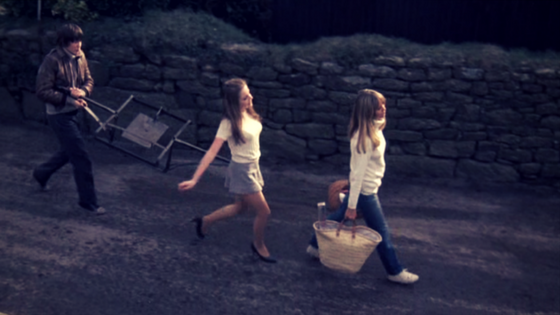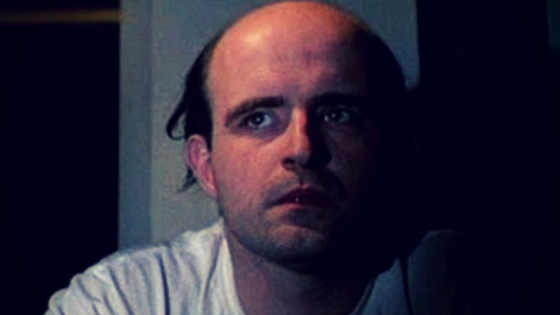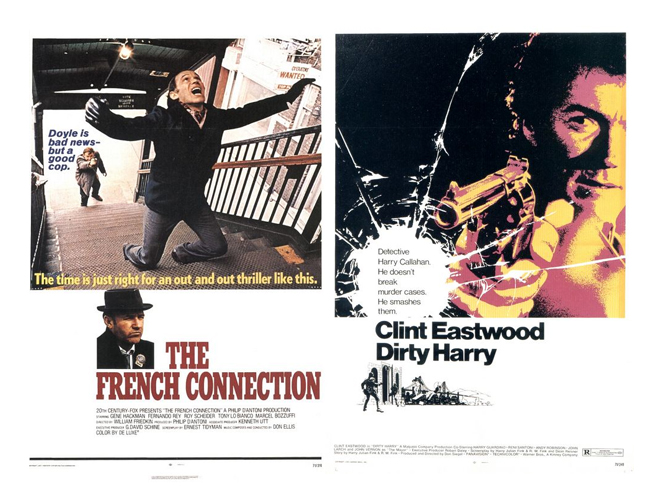Sam Peckinpah’s Straw Dogs (1971) has often been considered a difficult and controversial text. Central to this is the depiction of gender, specifically concerning the role of Amy (played by Susan George) and the double rape that she undergoes, and the suggestion that the film is a parable of male dominance wherein the central character, David Sumner (Dustin Hoffman), ascends to being a ‘real’ man via a violent siege against marauding Cornish locals. The tag-line, featured on several posters for the film, suggested this very reading;
The knock at the door meant the birth of a man and the death of seven others
Given the predominant view of the film as a story of male birth, or re-birth, a consideration of the psycho-sexual imagery seems relevant particularly considering the proliferation of such imagery throughout the film. Images of emasculation, castration and phallic power are consistently invoked and develop the theme of birth referred to in the advertising. Creed (1993) offers a suitable model for considering these images and I will refer to her work, and Julia Kriteva’s concept of abjection, to explore the meanings of the psycho-sexual imagery of Straw Dogs. I propose that Straw Dogs gives us a drama of identity crisis tied to anxieties about castration and phallic power which culminates in David Sumner’s rejection of home and decision to enter into the symbolic order having previously retreated from it. In addition to Creed I will also refer to the writings of American psychoanalyst Erik H. Erikson in investigating the identity crisis which runs through the film. Before entering into the analysis proper it is worth outlining the validity of mapping Creed’s analysis onto Straw Dogs. Creed was writing about women in horror, whereas this film is more concerned with men. I am not claiming the character of Amy as an instance of the monstrous feminine, rather that the concepts that Creed deals with are applicable outside of films which deal centrally with the female monster. There is also some debate about the genre classification of Straw Dogs itself, whether it fits into the horror genre. Many of its contemporary reviewers typed it simply as a relocated western, though this surely has as much to do with the presence of Peckinpah as the film’s autuer as it does for any specific textual evidence. I would suggest that the film is a hybrid of several generic elements, including those of horror and bears comparison with another contemporary British set horror The Wicker Man (Robin Hardy, 1973); both concern the intrusion of an outsider into a closed community, and both make extensive use of sexual imagery. Whereas The Wicker Man deals with a conflict between Catholic and Pagan morality Straw Dogs is concerned with a breakdown in identity that precipitates a re-birth of the protagonist. In its use of a corrupt, parodic, family, the Heddens, Straw Dogs also invokes other horror films from the 1970s such as The Texas Chainsaw Massacre and The Last House on the Left. Given the generic and thematic content of the film Creed seems a pertinent source for an analytical framework.
Castration & Emasculation
Castration and emasculation imagery runs through Straw Dogs from the earliest images of the film. It is immediately present in the gift given by Amy to David in the first moments, a large man-trap. As Creed points out “man-trap” is a phrase euphemistically used to refer to the vagina. The trap itself, with such jagged edges, invariably invokes the concept of the vagina-dentata. This image lurks throughout the film, opened up it takes a prominent place in the living room of the farm-house waiting to be closed in the siege where David makes use of it, enclosing it around an invader’s head (a clear image of castration). Beyond the image itself, the issue of ownership of the trap prompts questions about the relationship between David and Amy. It is given to David as a gift, one which he places in the home. We must for a moment consider what this means for the dynamic of their relationship. We may consider this an acquiescence on Amy’s part to David, offering him ownership of her genitalia. However the fact that it remains so threatening signifies her potential to castrate, one which remains until it is co-opted by David in the defence of the house. This immediately complicates the gender identity of David himself. The film consistently refers to David as a figure of impotence. Physically he is smaller than the local villagers. He is unable to drive an English car correctly (he cannot master the gear lever, another potentially phallic symbol). His sexual relationship with Amy is one of childishness and humour. Outside of the bedroom their relationship itself is one of tension. David is destructive, willful, and deeply narcissistic. When the local Vicar and his wife visit, David plays bagpipe music at full-volume (something he will repeat during the siege) and proceeds to alienate his guests, forcing them to leave. The reason for David to be in Cornwall is, ostensibly, to complete a mathematical work, however the dialogue suggests that he is running away, although it is not specific from what (an idea re-iterated in the film’s trailers). David’s behaviour is consistent with someone stuck in a preadult stage of development, a stage of weak identity. As Erikson outlines;
That many of our patients break down at an age which is properly considered more preadult than postadolescent is explained by the fact that often only an attempt to engage in intimate fellowship and competition or in sexual intimacy fully reveals the latent weakness of identity (1980, 134).
David’s manipulation of Amy, attempting to get her to engage with chess and other intellectual pursuits is also consistent with Erikson’s analysis of identity crisis;
For where an assured sense of identity is missing, even friendships and affairs become desperate attempts at delineating the fuzzy outlines of identity by mutual narcissistic mirroring (1980, 134).
And;
A sudden collapse of all capacity mutuality threatens, and a desperate wish ensues to start all over again, with a (quasideliberate) regression to a stage of basic bewilderment and rage such as only the very small child knows (1980, 135).
David’s identity is weak because it is not fully formed, revealed by his inability to form proper relationships (sexual or not). He has not yet taken his place within the symbolic order, rather he has run away from it and taken refuge in the farm-house or as I suggest, the womb that it represents. Given this, Amy takes on the appearance of a mother rather than a partner (Amy is, significantly, the only maternal figure in the film). The threat of castration is consistent with castration anxiety felt by the child. During the final siege it is Amy, not David, who will wield a phallic shot-gun in defence of the home, saving David’s life. Here Amy transfers from being a castrating mother to a phallic woman, embodying twin emasculating threats. Further images of emasculation surround David and other male characters in the film. A key moment occurs during the duck hunt (arranged so that Venner can approach Amy). Here David must be leant a gun, he lacks one of his one. When he does eventually kill a duck he holds it in his hands and its limp neck reflects his impotent and emasculated nature. Despite the lack of mothers, the film has a surfeit of fathers, however they are often shown to be symbolically emasculated themselves. The Major, who acts as the village’s law-man and patriarch, possess a limp. Tom Hedden is a drunk. Niles’ father is incapable of controlling his own son. Perhaps the most significant father figure in the film is an absent one; Amy’s. Much is made of the fact that the farm house is from Amy’s family, or more especially her father. When asked by David which of the chairs in the house was her fathers, she replies, “Every chair is my Daddy’s chair”. It places into crisis the ownership of the house and the presence of this father is a further emasculating force for David.
Re-Birth into the Symbolic Order
The symbolization of the womb as house/room/cellar or any other enclosed space is central to the horror film (Creed 1998, 55).
Straw Dogs acts as an exploration of the meaning of the womb, as both a secure and insecure place. It is linked to the concept of unheimlich, where something is familiar and uncanny at the same time, and its ability to “disturb identity and order” (Creed 1998, 54). As Creed identifies, Freud cites the womb phantasy as an occurrence of the unheimlich, a nexus of the familiar and unfamiliar. The womb is a place we both remember but can never know;
He (Freud) allocates a central place to the subject’s former ‘home’, the womb. The uncanny is that place which is ‘known of old, and long familiar’, the place from which the individual has become alienated through repression (Creed 1998, 54).
There is further potential for the home to be seen as the womb particularly in its passageways and entrances. The siege, when David’s crisis is brought to a head, plays on this imagery particularly. Earlier in the film, when Amy is raped and in other scenes, the thresholds to the house are seen as fluid. The rat-catcher’s ability to enter the house and kill the cat is an active demonstration of this. Also the penetration of the house by various gazes, be it the workmen or Janice and Bobby Hedden, shows it to be consistently invaded. What should we make of this? The rape of Amy and the sense of invasion suggests an elision between Amy and the house – they are both penetrated in various ways, some invited, some not. David’s sudden defence of it seems curious then, as he has so markedly failed to do so before. However it is the existence of Niles in the house that redraws the relationships and pushes David further along his identity crisis path. From here he takes the role of the castrating woman from Amy (freeing her to become the phallic woman later in the scene). He defends the home/womb and the childlike Niles within via a series of dentata like acts. The defence is focussed on the doorways and windows of the house. Knives and glass are used. Boiling oil, an invocation of abject fluid, is thrown out. Feet, hands and heads of the invaders are attacked, stabbed and engulfed. The blood, wounds, and death throughout the siege clearly invokes the abject. The nature of the home/womb as the site of this blood suggests fears of the abject mother; David has unnaturally returned to the comfort and safety of the womb space, he has subsequently attempted to assume the mantle of the castrating mother. The revealing of Amy as the phallic woman pushes David out – finally he is capable of being reborn. His closing exchange with Niles about not knowing the way home represents his final break with maternal authority and his entry into the symbolic order as a fully formed individual. Witness the final images of David, face covered in blood, an image of rebirth. Straw Dogs is a drama of the symbolic order. David’s rejection of his place in the order, and the identity crisis it precipitates, prompts the confusion and chaos that surrounds him. It can only be resolved by the violent ejection from the womb space he has attempted to return to in an attempt to reclaim safety from the world and the burdens placed upon him. The collection of emasculating imagery, emasculated characters and symbolic events that occur are the back drop which forces David to confront his own position and accept his true identity outside of the womb, apart from the mother and at the head of the symbolic order.
Works Cited
Creed, Barbera (1993) The Monstrous Feminine. Abingdon: Routledge
Erikson, Erik H. (1980) Identity and the Life Cycle. New York: WW Norton



